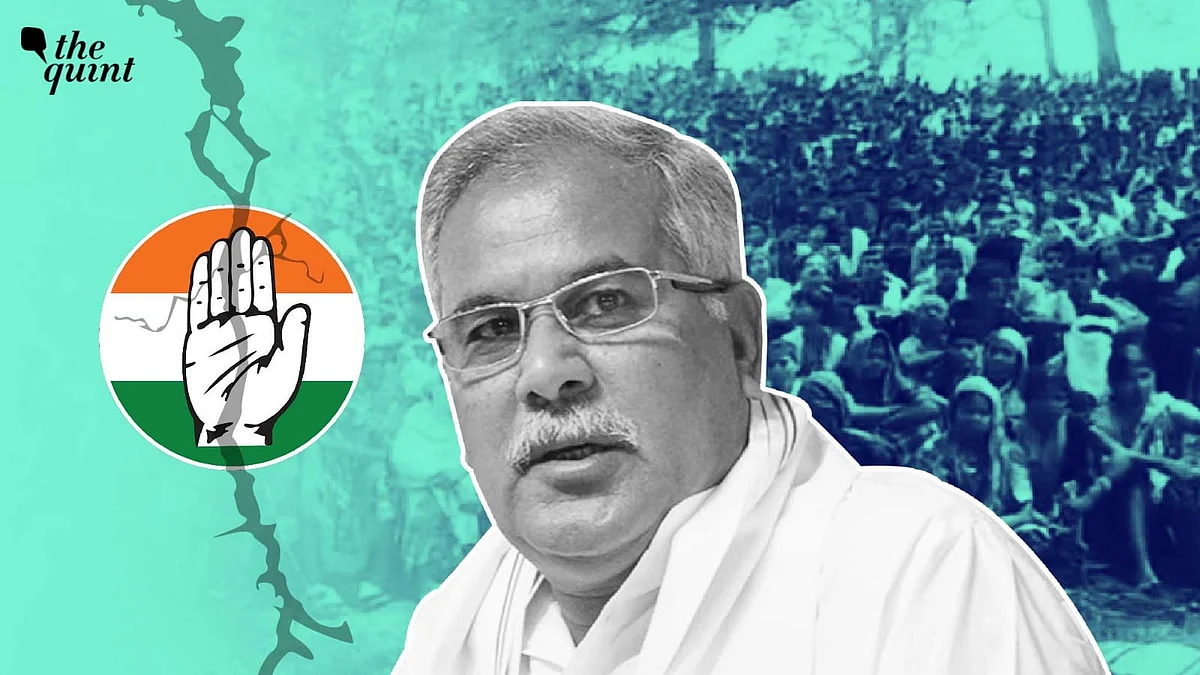
Congress Infighting to Tribal Protests, What Ails Chhattisgarh CM Baghel's Term?
Protests, party struggles, rising communal narrative – there's a lot Bhupesh Baghel needs to be wary of.

advertisement
With TS Singhdeo, Chhattisgarh's health minister and Chief Minister Bhupesh Baghel's top rival within the Congress, still hoping for a 'final decision' on the chief ministerial post in the state, Baghel's position has been put to test again.
Rekindling the controversy over the chief ministerial post in Chhattisgarh, Singhdeo on 2 April told the media at Raipur Press Club:
In December 2018, when the Congress government rose to power winning 68 out of the 90 Assembly seats in the state, the party leadership had apparently arrived at a two-and-a-half-year power-sharing formula between Baghel and Singhdeo. Although the friction between the two top leaders has been dismissed as rumours time and again, the rivalry has been visible throughout Baghel's tenure.
A Third Option Emerges – Aam Aadmi Party
On the other hand, the AAP's Chhattisgarh president, Komal Hupendi, denied that anyone had contacted Singhdeo. However, he added that "I urged him and all the leaders of the BJP (Bharatiya Janata Party) and Congress to join the AAP for the betterment of the state."
As the AAP tries to build and strengthen the organisation after its recent win in the Punjab elections, political analyst Parivesh Mishra told The Quint, "People won't just switch to the AAP right away, but it has become a third option for the disgruntled, dissatisfied leaders, and they will leave no chance to use the party as a leverage. Now, Baghel would have to do more than usual to keep all leaders happy, otherwise he would be at a greater loss – and the Congress would be looking at a downfall."
But the infighting isn't the only cause of worry for the incumbent government in Chhattisgarh. Along with the already visible rift within the party, a plethora of protests across state and the rise of a communal narrative, the road is tougher than it seems for the Baghel-led Congress in Chhattisgarh, which is set to go to elections in November-December 2023.
Prolonged Tribal Agitation in Chhattisgarh
Two tribal-led agitation in Chhattisgarh have dominated news from the state in recent times – the protests against coal mining in the Hasdeo Aranya region of north Chhattisgarh and the protests at various spots across Maoist-infested Bastar against security camps and police atrocities.
"The Bhupesh Baghel government has turned a blind eye to each of these protests, wishing for them to fade away. But what they fail to understand is that protests don't fade away," a senior journalist told The Quint on the condition of anonymity.
The Silger protest, which arguably became one of the biggest people's movements of recent times in Bastar, started in May 2021 after three tribals were allegedly killed when police opened fire on the protesting villagers. The protests continue till this day.
The Hasdeo Aranya region, too, has been seeing several protests. In October 2021, hundreds of tribals from Hasdeo Aranya marched over 300 km to reach Raipur and register their protest against the coal mining in the biodiversity-rich region. The protest is still simmering.
"People are coming out on the streets every other day – be it the tribals or people belonging to different unions. This will have an impact. The Baghel government is overlooking these protests, but it would harm them," the journalist added.
Is Wooing Rural Chhattisgarh With Freebies Enough?
Even the worst of Baghel's critics have applauded two of his moves – his effort to propagate 'Chhattisgarhiya' identity and regional patriotism, and his conscious effort to keep the rural voters happy.
Baghel's enthusiastic participation in events such as facing the whip on Gauri Gaura Puja and declaring a holiday on local festival Hareli Tihar, and the increasing use of Chhattisgarh dialect by both politicians and administration have all helped him bolster his image of being a 'Chhattisgarhiya Mukhyamantri'.
Further, commentators believe that though Baghel was initially successful in luring the rural voters of the state to his side with the paddy procurement rates and the Rajiv Gandhi Kisan Nyay Yojna, the payments under these schemes were made in tranches and haven't had the desired impact.
Around 75 percent of the total population of the state lives in villages, as per the 2011 census.
"He has worked well in rural Chhattisgarh, though not extraordinarily but he has put forward good policies. However, the urban population is still very much swayed by the BJP and the whole Modi magic coupled with nationalists emotions," commented a journalist from Raipur.
Baghel's Soft Hindutva Tactics Benefitting BJP?
Driving the communal narrative in the tribal state has shown good results for the BJP. So good that the ruling party and Chief Minister Baghel have quickly switched to the soft Hindutva mode themselves, inviting Hindu saints, organising events like Dharm Sansad, and felicitating those who installed the 108-foot-tall saffron flag in the Kabirdham district.
The Sarva Adiwasi Samaj on 29 March wrote to the Chhattisgarh governor, opposing the Ramayan Mandli Pratiyogita scheduled to be held on 29-30 March in Sukma district, citing infringement on fundamental rights and tribal customs in an area where the provisions of the fifth schedule of Article 244 (1) of the Constitution apply. The administration then had to cancel the event.
"One thing to accommodate is the fact that Baghel showing a little bit of Hindutva face will not harm him, at least if not do him any good," claimed Parivesh Mishra.
"One can see that Baghel's Hindutva card has led him to trouble. The government got called out for hosting the Dharm Sansad, for organising events like Ramayan recitation in tribal blocks, among other things. Tribals are noticing a change and also retaliating – and this will harm the Congress," they concluded.
- Access to all paywalled content on site
- Ad-free experience across The Quint
- Early previews of our Special Projects
Published: undefined